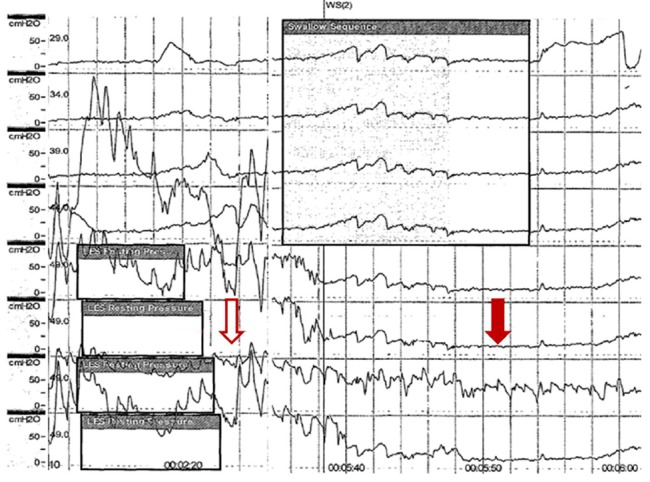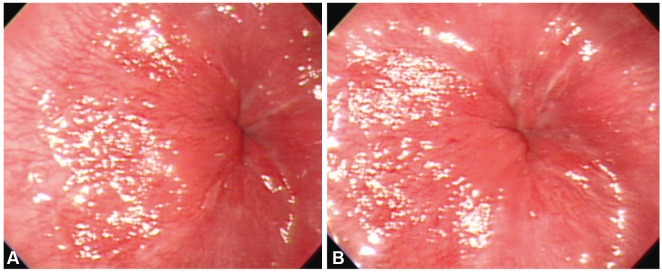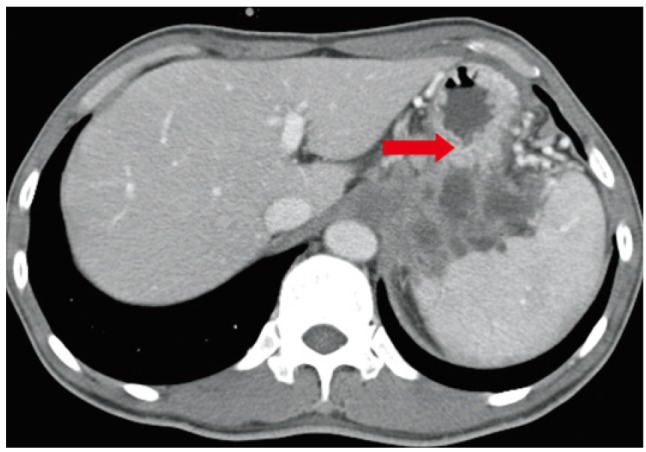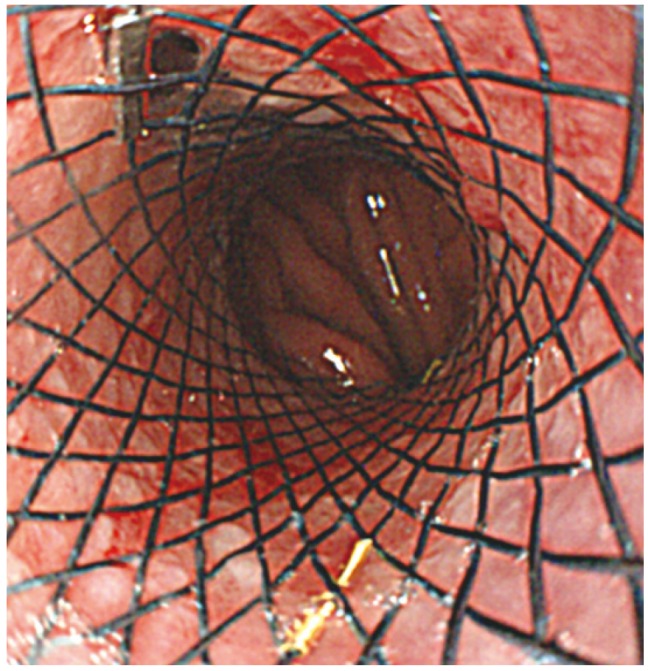Clin Endosc.
2015 Jul;48(4):328-331. 10.5946/ce.2015.48.4.328.
Extragastroesophageal Malignancy-Associated Secondary Achalasia: A Rare Association of Pancreatic Cancer Rendering Alarm Manifestation
- Affiliations
-
- 1Department of Internal Medicine, CHA Bundang Medical Center, CHA University, Seongnam, Korea. bluehipp@cha.ac.kr
- KMID: 1964277
- DOI: http://doi.org/10.5946/ce.2015.48.4.328
Abstract
- Secondary achalasia or pseudoachalasia is a rare esophageal motor abnormality, which mimics primary achalasia; it is not easily distinguishable from idiopathic achalasia by manometry, radiological examination, or endoscopy. Although the majority of reported pseudoachalasia cases are associated with neoplasms at or near the esophagogastric (EG) junction, other neoplastic processes or even chronic illnesses such as rheumatoid arthritis can lead to the development of pseudoachalasia, for example, mediastinal masses, gastrointestinal (GI) tumors of the liver and biliary tract, and non-GI malignancies. Therefore, even if a patient presents with the typical findings of achalasia, we should be alert to the possibility of other GI malignancies besides EG tumors. For instance, pancreatic cancer was found in the case reported here; only four such cases have been reported in the literature. A 47-year-old man was admitted to our center with a 3-month history of dysphagia. His endoscopic and esophageal manometric findings were compatible with primary achalasia. However, unresponsiveness to diverse conventional achalasia treatments led us to suspect secondary achalasia. An active search led to a diagnosis of pancreatic mucinous cystadenocarcinoma invading the gastric fundus and EG junction. This rare case of pseudoachalasia caused by pancreatic carcinoma emphasizes the need for suspecting GI malignancies other than EG tumors in patients refractory to conventional achalasia treatment.
MeSH Terms
Figure
Reference
-
1. Howarth W. Discussion on dilatation of the oesophagus without anatomical stenosis. Proc R Soc Med. 1919; 12(Laryngol Sect):64.2. Tracey JP, Traube M. Difficulties in the diagnosis of pseudoachalasia. Am J Gastroenterol. 1994; 89:2014–2018. PMID: 7942729.3. Kahrilas PJ, Kishk SM, Helm JF, Dodds WJ, Harig JM, Hogan WJ. Comparison of pseudoachalasia and achalasia. Am J Med. 1987; 82:439–446. PMID: 3548347.
Article4. Paulsen JM, Aragon GC, Ali MA, Brody FJ, Borum ML. Pseudoachalasia secondary to metastatic breast carcinoma. Dig Dis Sci. 2010; 55:1179–1181. PMID: 19421854.
Article5. Bustamante M, Devesa F, Ferrando MJ, Borghol A. Difficulty in the early diagnosis of pseudoachalasia of tumoral origin. Gastroenterol Hepatol. 2001; 24:144–145. PMID: 11261227.6. Liu W, Fackler W, Rice TW, Richter JE, Achkar E, Goldblum JR. The pathogenesis of pseudoachalasia: a clinicopathologic study of 13 cases of a rare entity. Am J Surg Pathol. 2002; 26:784–788. PMID: 12023584.7. McCallum RW. Esophageal achalasia secondary to gastric carcinoma. Report of a case and a review of the literature. Am J Gastroenterol. 1979; 71:24–29. PMID: 433888.8. Gockel I, Eckardt VF, Schmitt T, Junginger T. Pseudoachalasia: a case series and analysis of the literature. Scand J Gastroenterol. 2005; 40:378–385. PMID: 16028431.
Article9. Tucker HJ, Snape WJ Jr, Cohen S. Achalasia secondary to carcinoma: manometric and clinical features. Ann Intern Med. 1978; 89:315–318. PMID: 686541.
Article10. Sandler RS, Bozymski EM, Orlando RC. Failure of clinical criteria to distinguish between primary achalasia and achalasia secondary to tumor. Dig Dis Sci. 1982; 27:209–213. PMID: 7075419.
Article11. Licurse MY, Levine MS, Torigian DA, Barbosa EM Jr. Utility of chest CT for differentiating primary and secondary achalasia. Clin Radiol. 2014; 69:1019–1026. PMID: 24957858.
Article12. Rabushka LS, Fishman EK, Kuhlman JE. CT evaluation of achalasia. J Comput Assist Tomogr. 1991; 15:434–439. PMID: 2026805.
Article13. Richter JE. Achalasia: an update. J Neurogastroenterol Motil. 2010; 16:232–242. PMID: 20680161.14. Martinez C, Targarona EM, Sainz S, Cerdan G, Novell J, Trias M. Pseudoachalasia: a diagnosis to consider in the assessment of dysphagia. Gastroenterol Hepatol. 2000; 23:14–15. PMID: 10726378.15. Portale G, Costantini M, Zaninotto G, et al. Pseudoachalasia: not only esophago-gastric cancer. Dis Esophagus. 2007; 20:168–172. PMID: 17439602.
Article16. de Borst JM, Wagtmans MJ, Fockens P, van Lanschot JJ, West R, Boeckxstaens GE. Pseudoachalasia caused by pancreatic carcinoma. Eur J Gastroenterol Hepatol. 2003; 15:825–828. PMID: 12811315.
Article17. Pesce A, Scilletta R, Branca A, Portale TR, Puleo S. A rare case of pancreatic cancer presenting as pseudoachalasia. Ann Ital Chir. 2012; 2012:pii: S2239253X12019627.18. Kang CJ, Koh KH, Kim DH, et al. A case of pseudoachalasia accompanied by pancreatic cancer. Korean J Neurogastroenterol Motil. 2008; 14:57–60.
- Full Text Links
- Actions
-
Cited
- CITED
-
- Close
- Share
- Similar articles
-
- Three Cases of the Secondary Achalasia induced by Malignant Tumor
- A Case of Secondary Achalasia and Pyloric Stenosis due to Cholangiocarcinoma
- A Case of Secondary Achalasia due to Recurrence of Stomach Cancer
- Case of Concomitant Endoscopic Treatment of Achalasia with Superficial Esophageal Cancer
- A Case of Achalasia Diagnosed before the Detection of Colon Cancer with Multiple Metastasis






